AI in Demand Forecasting: How Artificial Intelligence Transforms Demand Prediction

Forecasting demand has never been more complex—or more critical. Traditional models, constrained by rigid statistical assumptions and outdated data, struggle to keep pace with the volatility of modern markets and the vast amounts of data they generate. Supply chains stretch across continents, consumer preferences shift unpredictably, and global disruptions can render months of planning obsolete overnight. However, AI in demand forecasting introduces a new era of predictive accuracy.
Unlike legacy models that rely on historical data and fixed algorithms, new technology integrates real-time market signals, external macroeconomic factors, and advanced pattern recognition to produce dynamic, continuously refined predictions. According to McKinsey, businesses that rely on intelligent forecast tools have reported accuracy improvements of 30-50%, translating into lower inventory costs, optimized supply chains, and increased profitability.
This article covers how AI improves forecast precision, the core technologies behind the shift, and the real-world impact across industries. If your business still relies on outdated forecast models, our AI software development company can guide you toward a smarter, data-led approach.
What is AI-Powered Demand Forecasting?
AI powered demand forecasting integrates machine learning (ML), deep learning (DL), and advanced analytics to process vast datasets and predict future demand patterns with unprecedented accuracy. Unlike traditional forecasting models that rely on linear regressions or time-series extrapolations, AI-driven models analyze multidimensional datasets, accounting for:
- Historical sales data – Identifies long-term purchasing trends and cyclical demand fluctuations
- Macroeconomic indicators – Assesses inflationary pressures, interest rates, and GDP growth to refine projections
- Consumer sentiment analysis – Extracts insights from social media, online reviews, and search trends
- External disruptions – Incorporates real-time factors such as geopolitical events, extreme weather, and supply chain bottlenecks.
AI demand forecasting pulls together structured and unstructured data from multiple sources to go beyond reactive plans. It delivers proactive, data-led insights that support stronger decisions. But AI models do not remain static. They evolve, adjust, and update forecasts as new data appears. This ability to adapt gives AI demand planning a clear advantage over traditional approaches.
AI-Driven Demand Forecasting Architecture
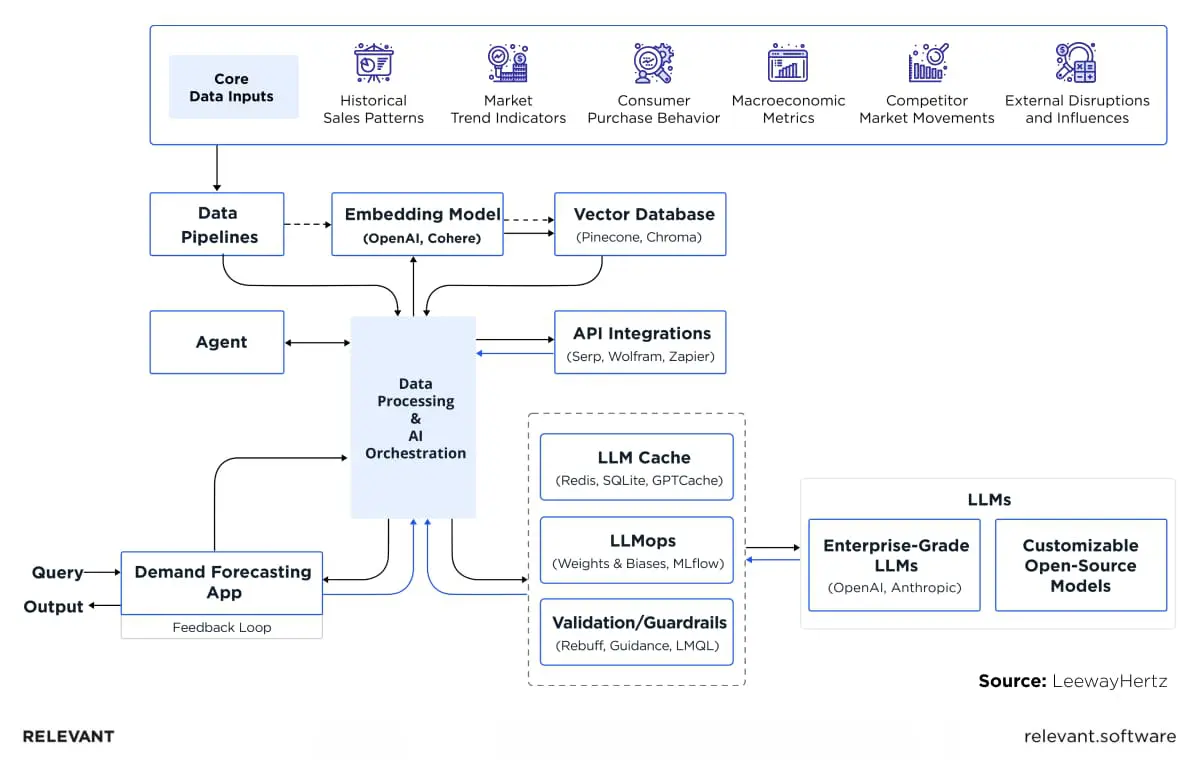
Core technologies behind AI forecasting
Traditional forecasting depends on static models that fail to adjust when markets shift, which often results in costly errors. AI-powered demand forecasting uses ML, real-time data, and predictive analytics to anticipate changes before they unfold. This approach delivers stronger accuracy, sharper inventory control, and better decisions across the board.
Relevant Software experts have outlined the core technologies that enable this shift—combining data integration, scalable infrastructure, and adaptive algorithms to transform how enterprises forecast and operate.
Machine Learning models for demand forecasting
Machine learning in demand forecasting identifies non-obvious correlations within massive datasets. The most effective models include:
- Time-series models – Reveal seasonal demand cycles, trend shifts, and outliers
- Regression models – Map relationships between prices, promotions, and sales volumes
- Decision trees – Provide structured logic for complex forecast scenarios
- Neural networks – Capture subtle, nonlinear signals across multiple variables
Supervised models build accuracy by learning from historical demand. Unsupervised models detect hidden demand signals without prior labels. Reinforcement learning further enhances adaptability, which allows AI to refine its forecasts based on real-world outcomes.
Deep learning and neural networks in demand forecasting
DL models elevate demand forecasts by handling complex, high-dimensional data with unmatched depth. Two core neural networks push accuracy to a new level:
- Long Short-Term Memory Networks (LSTMs) – Capture long-range patterns in sequential data, which boosts time-series forecast precision
- Recurrent Neural Networks (RNNs) – Track temporal shifts in demand and adjust output as conditions change
According to the experience of Relevant Software’s clients, these models allow AI to detect nonlinear demand triggers and deliver reliable forecasts, even in volatile markets where traditional methods fall short.
Big data and predictive analytics
Demand forecasting with AI capitalizes on big data analytics to refine predictive models far beyond what conventional approaches—often limited to internal sales records—can achieve. It uses:
- Point-of-sale (POS) data – Tracks real-time purchasing behaviors across multiple retail locations
- Digital engagement metrics – Analyzes consumer interactions across websites, mobile apps, and online marketplaces
- Economic and geopolitical indicators – Accounts for inflation, trade policies, and regional economic fluctuations
AI uses predictive analytics to turn raw data into actionable forecast insights. This shift strengthens supply chain precision and supports a clear financial strategy.
Real-time forecasting with AI and IoT integration
AI and IoT now work together to enable real-time demand forecasts, far beyond what batch-based systems can deliver. IoT smart shelves and RFID sensors feed continuous stock-level data into AI systems, which adjust forecasts without delay.
Key use cases include:
- Automated inventory control – Smart shelves and RFID sensors report stock status in real time, so AI updates forecasts with precision
- Connected logistics – AI reads supply chain conditions to prevent delays and avoid production slowdowns
- Real-time pricing decisions – AI sets optimal prices based on current demand and market behavior
The Relevant Software team emphasizes that with live data from IoT systems and real-world inputs, businesses move beyond reactive planning toward a demand forecast model that responds with speed, precision, and confidence.
Natural Language Processing (NLP) for sentiment analysis
AI-driven sentiment analysis pulls demand signals from unstructured text across digital platforms. NLP gives organizations the ability to:
- Monitor consumer sentiment – Spot trends in online discussions and product reviews
- Analyze competitive positioning – Measure shifts tied to rival brands or new product launches
- Detect demand anomalies – Catch abrupt changes in preferences before they affect sales
With sentiment analysis within AI demand forecasting, businesses stay ahead of market shifts, shorten response time, and align inventory more closely with actual consumer behavior.
Key benefits of AI in demand forecasting
Traditional forecasting depends on static models that fail to adjust when markets shift, often resulting in costly errors. Intelligent demand forecasting replaces outdated methods with machine learning, real-time data, and predictive analytics to improve inventory alignment, reduce operational costs, and increase profit margins across marketing campaigns.
This approach enables sharper forecasts, faster decision-making, and greater responsiveness to sudden market shifts. Businesses gain stronger forecast accuracy, optimize stock levels, and move from reactive planning to proactive control.
Relevant Software’s team of product developers and consultants enables enterprise teams to unlock these benefits through scalable AI platforms built on proven data pipelines, real-time integrations, and domain-specific models, ensuring measurable ROI from day one.
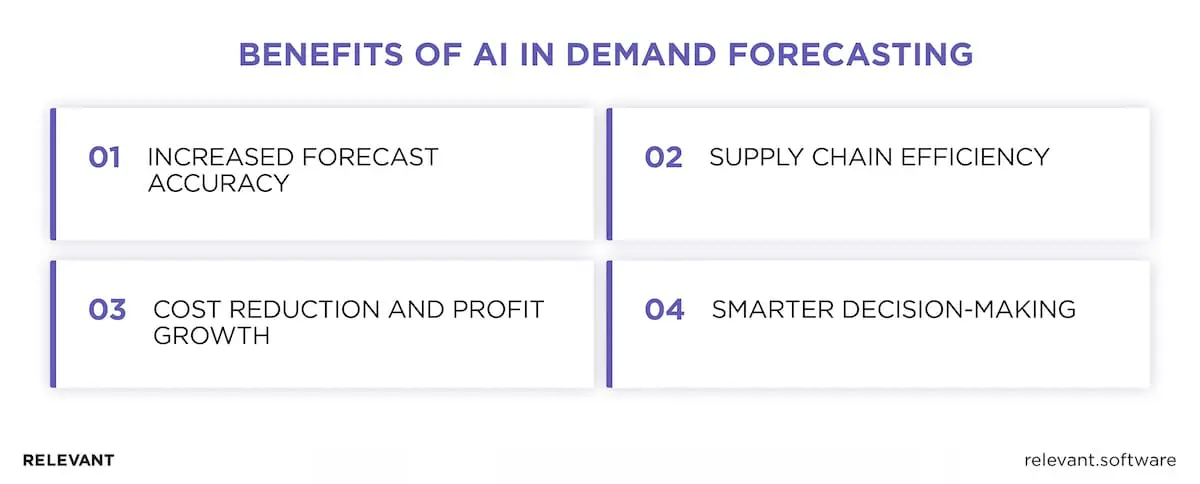
Increased forecast accuracy
Traditional forecasting relies on outdated models that fail to respond to unpredictable market shifts. AI-powered demand forecasting removes these limits by using real-time market signals, competitor moves, and supply chain data to keep forecasts accurate, providing insights into customer demand and market trends—even under volatile conditions.
Relevant Software’s team of seasoned product developers and industry analysts, backed by deep market research, reports that companies using AI demand forecast software in supply chain management see up to 50% fewer errors. This sharp drop cuts the cost of stock shortages and surplus. Amazon and Walmart, for example, use AI to manage inventory with precision, placing products exactly where and when they must arrive—without excess. As AI reveals hidden demand signals, businesses move beyond historical data and adjust forecasts based on real-time market shifts.
Supply chain efficiency
Stockouts and excess inventory reflect the same costly issue—poor demand forecasting. AI-powered demand forecasting tools adjust stock levels based on live sales data, warehouse status, and real demand signals. This removes rigid, outdated replenishment cycles that often cause bottlenecks across the supply chain.
Instead of relying on fixed lead times, AI uses real-time logistics and warehouse inputs to detect when stock levels require correction before shortages or overages occur. In logistics, companies use AI-driven demand forecasts to refine distribution networks, cut lead times, and strengthen supply chain resilience.
Cost reduction and profit growth
Forecast errors create avoidable costs. Overstock leads to storage fees, markdowns, and tied-up capital, while understock leads to missed sales and supply chain disruption. AI-based demand forecasting matches inventory to real demand, cuts waste, and improves working capital efficiency.
Retailers that adopt AI-powered demand planning solutions see fewer markdowns and stronger margins. Dynamic price models powered by AI set prices based on real-time demand, competitor moves, and seasonal shifts.
Smarter decision-making
AI does more than improve forecasts—it shapes strategic choices across inventory control, market direction, and pricing structure, ultimately enhancing customer satisfaction. Traditional models depend on static reports that often lose value before executives respond. AI, by contrast, delivers real-time insight, so businesses anticipate and respond to shifts without delay.
With AI powered demand forecasting tools, companies explore multiple demand scenarios and assess how economic shifts, competitor moves, or supply chain shocks affect future sales. Generative AI pushes this further, simulating complex market environments to give businesses a forward edge without reliance on past trends.
Across our work with enterprise clients, we’ve seen how modern forecasting platforms—rooted in machine learning, generative models, and real-time data—reshape operational agility. Rather than reacting to disruptions, companies plan ahead, allocate resources with precision, and uncover new growth opportunities backed by predictive confidence.
Relevant Software’s team of product developers and consultants enables this shift by delivering scalable AI systems built on robust data pipelines, real-time integrations, and domain-specific models, ensuring measurable ROI from day one.
For a closer look at how we build and deploy these solutions, explore our AI development process article.
AI demand forecasting use cases across industries
AI-based demand forecasting now serves as a strategic lever across sectors. Instead of relying on static models, businesses use advanced demand forecasting methods to capture fast-moving market dynamics and extract actionable insights from various sources —real-time transactions, sensor data, external signals, and more.
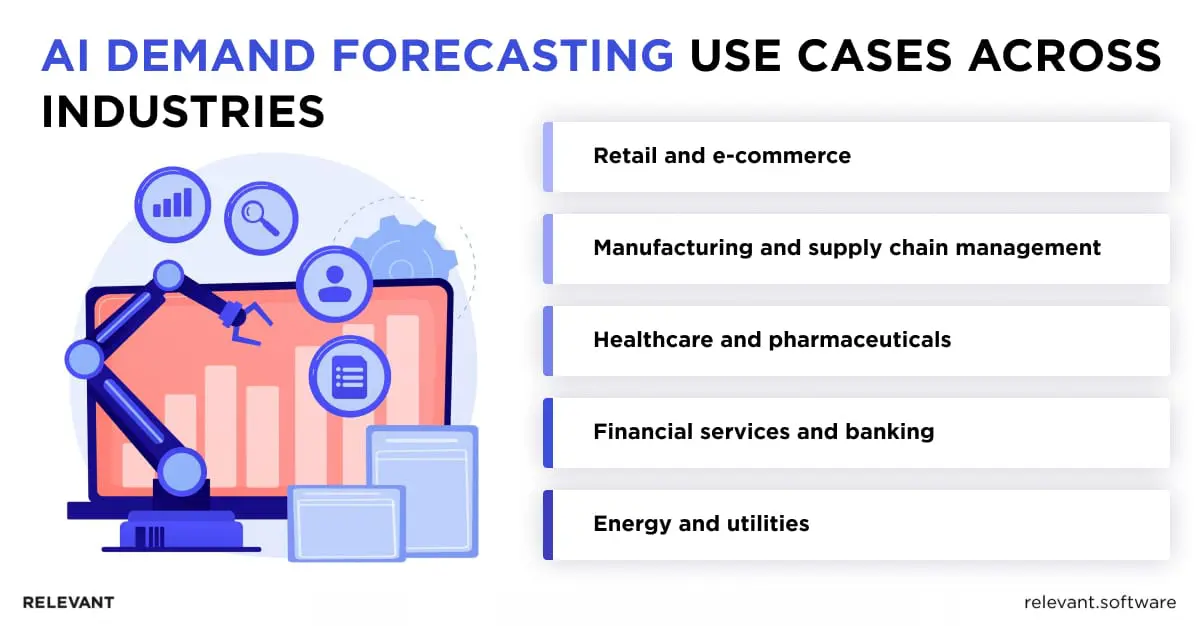
Retail and e-commerce
Retail demands precision. Overstock creates waste, markdowns, and tied-up capital, while stockouts result in lost sales and poor customer service. Accurate demand forecasting powered by AI enables retailers to anticipate demand shifts with surgical precision through real-time data analysis, customer behavior, and external factors like weather patterns or social sentiment.
AI refines marketing strategies, automates stock allocation, and aligns promotions with true demand signals. Market leaders like Amazon apply AI to maintain near-perfect inventory levels, while intelligent pricing models prevent unnecessary markdowns and protect profit margins. Businesses that apply AI in e-commerce secure a competitive edge by anticipating consumer behavior rather than reacting to it, boosting both profitability and responsiveness.
Manufacturing and supply chain management
Manufacturers face high-stakes decisions that require more than rough estimates. Traditional and manual methods fail to adapt when market changes arise or bottlenecks appear. AI-based demand forecasting now plays a central role in supply chain planning, where responsiveness and precision determine success.
By processing large volumes of data from IoT sensors, vendor platforms, and shipping systems, AI identifies early disruptions and corrects forecasts before problems escalate. With better visibility across networks, businesses improve forecast accuracy, reduce overproduction, and maintain inventory balance under pressure.
AI in logistics also enhances dynamic pricing in manufacturing, where fluctuating input costs and changing market conditions demand real-time pricing adjustments. These AI tools push production closer to demand in both timing and volume.
Healthcare and pharmaceuticals
In healthcare, accurate forecasts mean more than profit—they support care delivery, resource allocation, and patient outcomes. AI-based systems outperform outdated models by combining diverse data sources: hospital admissions, disease trends, regional health data, and global supply chain metrics.
This multifaceted approach boosts forecast accuracy and ensures hospitals and suppliers maintain critical stock levels—without overloading shelves. During COVID-19, AI models identified equipment shortages well before traditional systems responded. Now, pharma companies use similar tools to align vaccine production with projected need.
These advances reflect the broader advantages of using AI in healthcare, where AI improves diagnostics, guides patient care, and supports operational decisions with greater speed and precision.
Financial services and banking
Financial institutions must predict consumer spending, lending demand, and market shifts. Traditional forecasting tools fail under fast-moving conditions, while AI-driven models process complex financial datasets in real time and refine projections as new variables emerge.
Banks use AI forecasting to improve credit risk models, so lending strategies stay aligned with economic shifts before defaults increase. Hedge funds and investment firms apply AI-powered analytics to predict market swings and asset demand, shaping portfolios with greater precision. AI goes beyond forecasts—it directs capital with sharper insight, limits risk, and unlocks new opportunities.
Energy and utilities
Energy use shifts due to seasons, industrial output, geopolitical events, and weather. AI-powered demand forecasting helps energy providers predict these shifts with greater accuracy, so supply matches demand without excess or shortage.
AI systems analyze past usage data, economic indicators, and climate forecasts to deliver more accurate demand forecasting. Utilities that implement AI-based demand planning minimize waste, stabilize grid loads, and improve margins through real-time responsiveness. As energy markets grow more volatile, AI helps organizations maintain resilience and protect long-term operational efficiency.
How to implement AI for demand forecasting in your business
An AI-based forecasting system does not work as a plug-and-play solution. It marks a strategic shift that demands clear strategic planning, high-quality data, and disciplined execution. Businesses that succeed do not toss AI algorithms at the problem—they build systems where technology adapts over time and responds to new inputs with greater precision.
When built correctly, AI-powered demand forecasting tools cut error rates, align inventory with real demand, and uncover deep insights. When built poorly, a flawed model causes damage at scale—just like a bad forecast, only faster. To avoid that outcome, we break down the AI adoption process step by step.
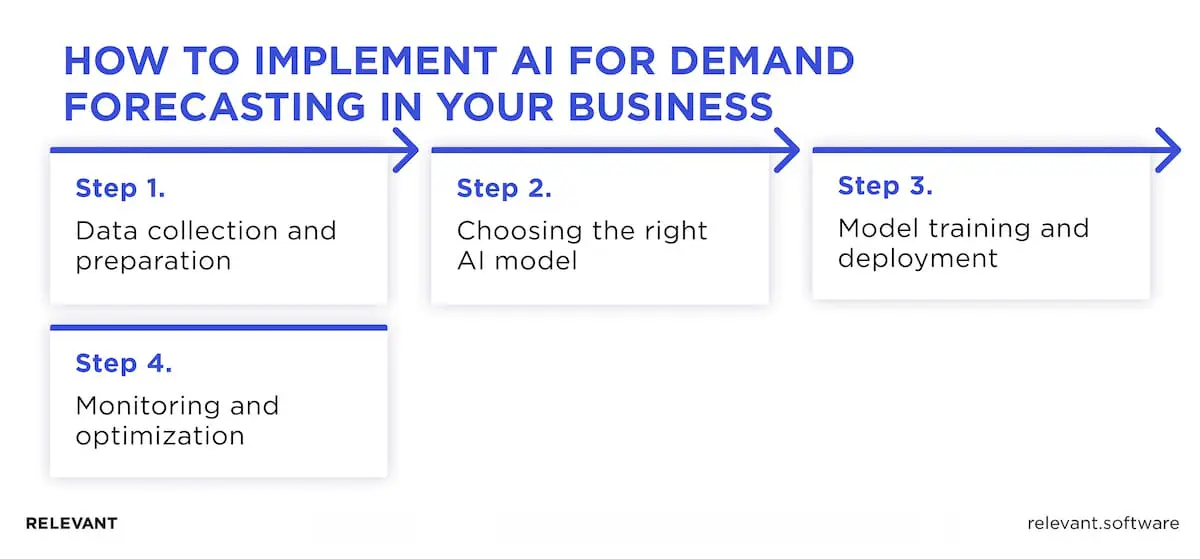
Step 1: Data collection and preparation
AI models depend entirely on the quality of the data they receive. Incomplete, outdated, or irrelevant inputs lead to poor results, comparable to expecting precision engineering with the wrong parts.
Successful demand forecasting using AI begins with structured, complete, and reliable data. Key inputs include:
- Historical sales data – Forms the baseline for every forecast. AI detects patterns, seasonality, and outliers
- Customer behavior data – Includes search habits, purchase records, and social sentiment. Shoppers may claim to resist new gadgets, but AI spots what they truly want
- External influences – Covers economic trends, competitive shifts, weather, and geopolitical events—all of which shape demand beyond past sales
After collection, the data must go through strict preparation. AI rejects inconsistency. Gaps, duplicates, or disorganized formats lead to errors. Before an AI model runs, data must pass through normalization, error removal, and restructuring to fit the format AI models require.
Step 2: Choosing the right AI model
Not all AI models serve the same purpose. Some offer speed, others deliver accuracy, and a few prioritize clarity. A poor model choice for AI in demand forecasts mirrors using a sports car to move freight—high performance, but no alignment with the task.
Machine Learning (ML) Models
- Regression models – Clear, straightforward, and effective for stable demand patterns
- Decision trees – Fit for structured, rule-based logic but prone to error when rules grow too complex
- Random forests – A more robust tree-based approach that improves accuracy by reducing variance
Deep Learning (DL) Models
- Long Short-Term Memory Networks (LSTMs) – Handle time-series data well and capture long-range patterns
- Recurrent Neural Networks (RNNs) – Suit sequential demand flows such as seasonal trends
- Transformer-based models – Power modern systems like ChatGPT and handle complex demand signals at scale
Each model involves trade-offs. Higher accuracy may reduce interpretability. Traditional firms may lean toward regression models for clarity, while tech-driven businesses may favor DL for its power, even if it requires deeper technical oversight.
Step 3: Model training and deployment
Now begins the phase where AI builds its forecasting power—not through intuition, but through pure computation. AI in demand planning depends on large volumes of historical data, data processing, careful model adjustment, and the ability to apply insights to new market conditions.
Key steps in model setup:
- Data segmentation – Divide data into training, validation, and test sets to avoid overfitting and ensure accuracy
- Feature selection – Pinpoint key inputs. Does social sentiment shape demand? Should weather data inform the forecast? AI needs structured, relevant signals—not guesswork
- Historical and external data input – Go beyond past sales. AI must process macroeconomic shifts, competitor behavior, and external shocks to refine its output
Once ready, the model enters production. At that point, businesses move from theory to action—connecting AI to ERP, CRM, and inventory systems so forecasts guide real-time decisions rather than static plans.
Step 4: Monitoring and optimization
No AI model remains perfect indefinitely. A forecast built on pre-pandemic sales data, for example, may fail to reflect demand patterns in a post-pandemic world. Businesses that treat AI as a one-off setup, rather than a system that evolves, often return to square one.
Regular updates and model adjustments remain essential. They include:
- Performance checks – Track accuracy over time to catch drift when forecasts lose precision due to market shifts
- New data input – Add fresh demand signals from competitors, supply chains, or consumer shifts
- Model comparison – Test updated versions against older ones to confirm improvements
A well-maintained AI powered demand forecasting system adapts with the market, sharpens over time, and keeps decision-makers ahead of change.
As a company recognized by Clutch and GoodFirms, we understand what it takes to deploy AI solutions that drive real impact. Our expertise ensures that AI doesn’t just forecast demand—it anticipates challenges, optimizes operations, and strengthens decision-making at scale.

Challenges in AI demand forecasting implementation
AI in demand forecasting often seems like a perfect solution—add data, and the supply chain optimizes itself. In reality, AI requires a strategic approach, more like a high-stakes chess match than a simple switch flip. Companies that overlook key challenges risk inaccurate predictions, failed system integrations, or—worst of all—lost executive confidence.
What stands between AI-powered demand forecasting and real business impact? Let’s take a closer look.
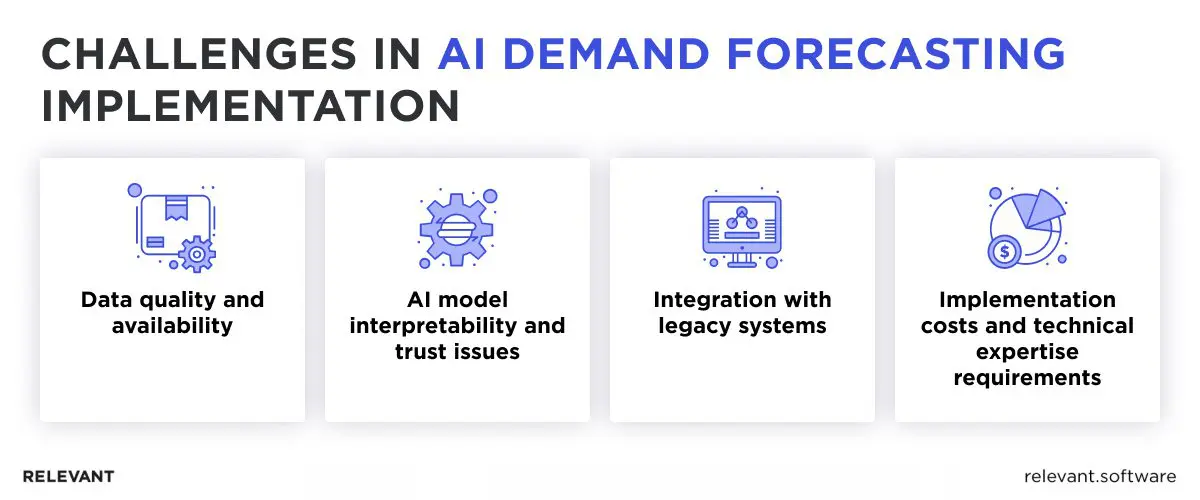
Data quality and availability
AI models rely entirely on the quality of the data they process. If datasets contain errors, gaps, or inconsistencies, an AI-powered demand forecast will offer no better results than an intern relying on instinct to predict sales.
Effective AI demand forecasting depends on structured, accurate, and comprehensive data, as well as:
- Historical sales trends with multi-year insights
- Consumer behavior patterns, preferences, and external demand drivers
- Macroeconomic indicators such as inflation, interest rates, and market conditions
- Supply chain performance data, which includes lead times and disruptions
The challenge? Many businesses store data across multiple systems, often incomplete or full of errors—duplicates, missing timestamps, or inconsistent formats. Standardization, deduplication, and external data integration must take place before AI can extract valuable insights.
Without a strong data governance framework, AI in demand forecasting loses its ability to provide reliable predictions. AI must operate with full visibility, and that starts with high-quality, structured data.
AI model interpretability and trust issues
Executives value AI—until it produces results they can’t explain. One of the main hurdles in AI based demand forecasting lies in the lack of clarity. Deep learning models often reach high levels of accuracy, yet they behave like black boxes. When an AI system signals a 30% demand drop for the next quarter without a clear reason, doubt takes hold.
Interpretability remains essential for business adoption. Demand forecasting AI tools must do more than show numbers—they must reveal the drivers behind the forecast, whether that stems from a shift in consumer sentiment, a competitor’s price move, or changes in macroeconomic conditions.
Bridging the trust gap requires:
- AI explainability tools (e.g., SHAP values, LIME) to provide transparency on why a forecast changed
- Human-in-the-loop systems, where analysts review AI recommendations before decisions are automated
- Clear documentation of model inputs so executives can validate AI’s logic against real-world market conditions
The goal isn’t just to generate AI-powered demand forecasting insights—it’s to make them actionable and trustworthy. Without this, businesses risk AI models being ignored, overridden, or worse—blamed when forecasts go wrong.
Integration with legacy systems
AI operates at the cutting edge, but most enterprise systems do not. Legacy ERP, supply chain, and inventory management platforms lack the foundation to support AI-driven demand forecasts, which creates serious obstacles.
Common issues include:
- Rigid system architectures that fail to process real-time AI forecasts
- Data silos that trap key demand insights in disconnected platforms
- Limited API access that blocks AI adoption and inflates costs
Without a modern data infrastructure, even the most advanced AI demand forecast models sit idle, disconnected from core operations and unable to deliver impact.
Implementation costs and technical expertise requirements
AI-powered demand forecasts do not fall under DIY efforts. A functional system demands high-performance computing, cloud infrastructure, and specialized expertise—all of which add significant cost.
Key cost factors include:
- AI model training infrastructure – GPUs, cloud computing, and data storage
- Data pipeline development – Data ingestion, transformation, and integration
- Talent acquisition – Data scientists, AI engineers, and MLOps specialists
For companies without in-house expertise, AI outsourcing offers a scalable, cost-effective path to adopting AI internally. However, even with external support, continuous model updates and refinements remain essential—AI that fails to evolve with new data loses accuracy and becomes a liability rather than an asset.
Trends in AI-powered demand forecasting
AI demand forecasting continues to evolve beyond prediction—it now guides real-time decision-making across supply chains, finance, and customer engagement. As systems grow more autonomous, they no longer rely solely on past patterns. Instead, they simulate entire market environments, test decisions before execution, and align operations with unfolding future trends.
Enterprises that adopt this next generation of forecasting systems gain more than speed or accuracy—they gain foresight. With AI processing extensive data across sectors, companies can pivot faster, deploy resources smarter, and achieve continuous improvement to stay ahead of disruption.
Autonomous demand planning
Today, AI enables businesses to forecast demand with remarkable precision. Soon, it will do far more—executing demand decisions without human intervention. Imagine an AI system that not only predicts demand shifts but also adjusts procurement, corrects inventory levels, and triggers supply chain responses before any planner intervenes. This marks the next frontier in the future of AI in demand forecasting, where systems move from decision support to full autonomous execution.
This shift toward autonomous demand control relies on advances in real-time AI, reinforcement learning, and the integration of diverse external data sources. AI interprets consumer sentiment, macroeconomic signals, and supply chain pressures to keep inventory aligned with real-time demand, eliminating guesswork entirely. Companies that embrace this model move beyond reactive planning, building automated systems that identify risks and seize opportunities faster than any human team.
Generative AI in forecasting
Generative AI no longer serves only chatbots or content tools. It now plays a pivotal role in demand forecasts, with the power to simulate future scenarios and improve accuracy based on potential market shifts.
Unlike traditional models that rely solely on historical data, generative AI builds synthetic demand scenarios. This gives businesses a way to test economic shocks, competitor moves, or supply chain failures before they unfold.
A retailer, for instance, may use generative AI to assess the impact of a competitor’s flash sale. A manufacturer may simulate a global shipping delay to understand how it affects raw material supply. These AI-driven scenarios support early adjustments to inventory and pricing well before real-world data shows the impact.
AI-powered prescriptive analytics
Forecasting demand is only the first step. The real advantage appears when AI not only predicts outcomes but also defines the best course of action and follows through. This is the role of AI-powered prescriptive analytics. Unlike predictive models that focus on future demand, prescriptive analytics selects the right response to each scenario.
For example, if AI detects a demand surge ahead, prescriptive analytics can:
- Adjust procurement orders to avoid stockouts
- Shift marketing efforts to capture peak demand
- Set new price points to boost revenue
By combining AI-powered demand forecasting tools with prescriptive logic, businesses move from “what might happen” to “what should we do now”—without delays or second guesses.
Our AI success story: AstraZeneca’s CRM transformation
At Relevant Software, we specialize in AI implementation that delivers measurable business results. One of our success stories shows how AI transformed operations at AstraZeneca, a global pharmaceutical leader facing a major CRM data bottleneck.
Their Medical Affairs teams faced millions of records. Manual review slowed progress and consumed valuable resources. In addition to the inefficiencies, the company had to meet strict FDA, EMA, HIPAA, and GDPR compliance requirements. They needed an AI solution that ensured both speed and precision.
We built an AI-powered CRM and analytics platform using ChatGPT and Llama-2 to process over 350,000 CRM records with high accuracy. This removed the manual burden and gave Medical Science Liaisons (MSLs) immediate access to AI-driven insights that improved engagement with healthcare professionals. Built on Google Cloud and optimized with TensorFlow and PyTorch, the platform:
- Cut manual CRM processing time by over 20 hours per week
- Lowered market access costs by 50%
- Provided instant, data-driven intelligence at enterprise scale
Beyond automation, the system introduced role-based security, end-to-end encryption, and advanced AI-driven compliance monitoring, which ensured that AstraZeneca met the industry’s highest regulatory standards while unlocking unprecedented operational agility.
Implement AI demand forecasting with Relevant Software
As an experienced IT software development company, we deliver AI systems that align with enterprise infrastructure and drive real outcomes in real-world supply chains, where accuracy drives profit, resilience protects operations, and timing defines competitiveness.
Our AI demand forecasting systems are:
- Enterprise-ready – Built to align with ERP, CRM, and inventory platforms
- Accurate and adaptive – Designed to detect real demand shifts, not just follow historical trends
- Fast and scalable – Capable of processing large, multi-source datasets in real time
- Transparent and trusted – With explainable output, your team can understand and act on
We support retailers, manufacturers, distributors, and finance teams with ML and AI in software development—building systems that cut stockouts, reduce waste, and sharpen pricing decisions. If your business needs an AI partner to anticipate demand, move fast, and grow without limits, reach out to us.



